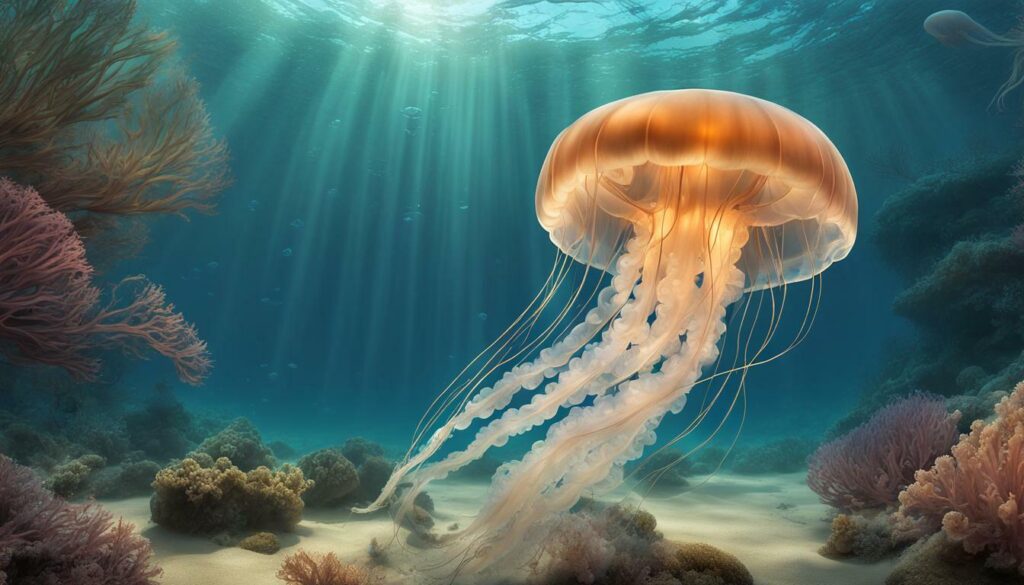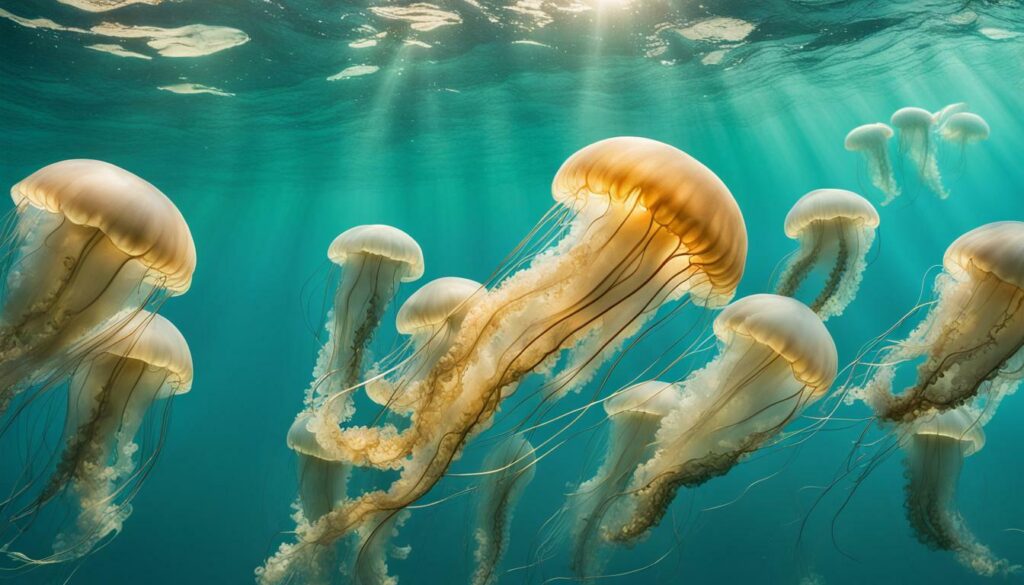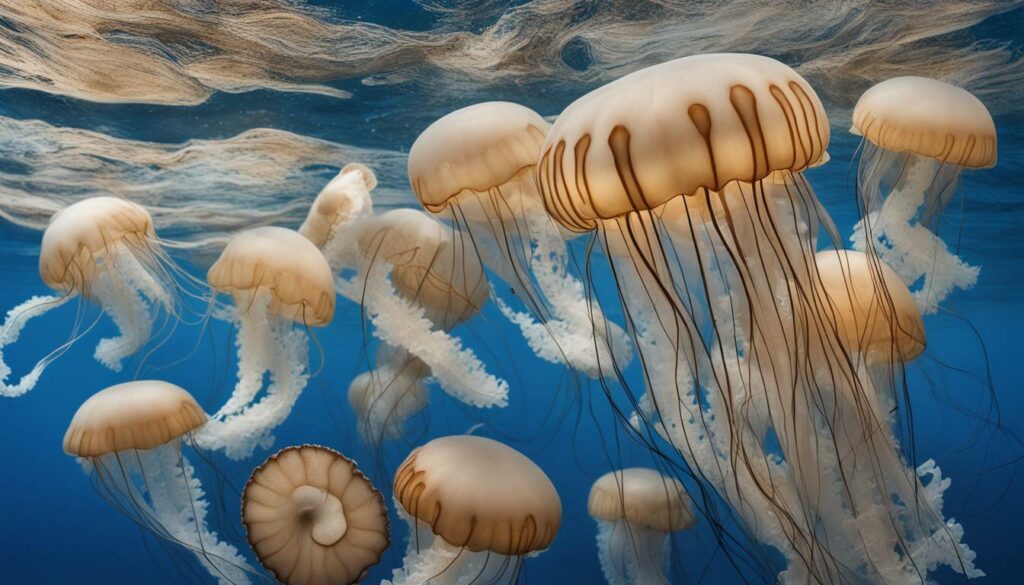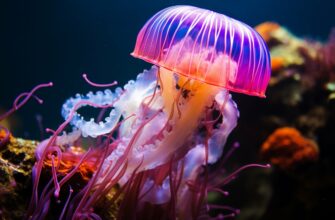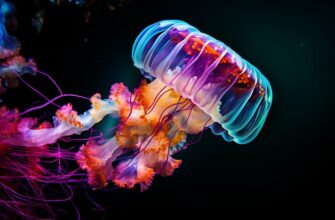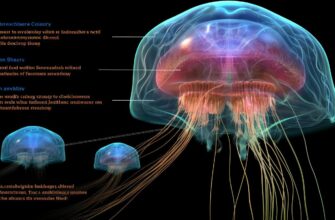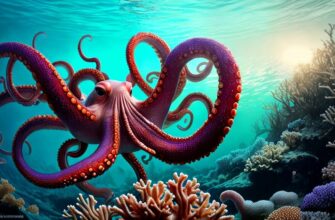Whether you’ve seen them at the beach or in a documentary, jellyfish are undoubtedly fascinating creatures. What’s even more intriguing is their unique way of moving through the water.
Jellyfish are not fish at all, but rather invertebrates that belong to the phylum Cnidaria. They move through the ocean using a unique motion that is different from any other marine creature.
So how do jellyfish move? Let’s explore the secrets behind their locomotion and swimming techniques in this article.
- Key Takeaways:
- Jellyfish Locomotion: A Remarkably Unique Way of Swimming
- Jellyfish Locomotion Techniques
- Understanding Jellyfish Muscle Contractions and Propulsion
- The Mechanisms Behind Jellyfish Movement
- The Surprising Diversity of Jellyfish Swimming Patterns
- Jellyfish Navigation Tactics: Moving with Purpose
- Environmental Factors Affecting Jellyfish Movement
- Conclusion: The Marvels of Jellyfish Motion
- FAQ
- Q: How do jellyfish move?
- Q: What are the swimming techniques employed by jellyfish?
- Q: How do jellyfish propel themselves through the water?
- Q: What are the mechanisms behind jellyfish movement?
- Q: What are the different swimming patterns observed in jellyfish?
- Q: How do jellyfish navigate their surroundings?
- Q: How do environmental factors affect jellyfish movement?
- Q: What are the marvels of jellyfish motion?
Key Takeaways:
- Jellyfish have a unique way of moving through water that sets them apart from other marine creatures.
- Despite their name, jellyfish are not fish, but rather invertebrates that belong to the phylum Cnidaria.
- In this article, we will delve into the intricate muscle contractions and propulsion that enable jellyfish to glide through the water with ease.
Jellyfish Locomotion: A Remarkably Unique Way of Swimming
Jellyfish have a remarkable way of swimming that sets them apart from other marine creatures. Unlike fish, which use their fins to move forward, jellyfish use a motion called pulsing. They contract their bell-shaped bodies to push water away and propel themselves forward.
This pulsing movement is not only unique but also incredibly efficient. Jellyfish can move through the water using very little energy, making them highly adaptable to their surroundings. This is especially important since jellyfish are found in a wide range of marine environments, from the deep sea to coastal waters.
Another interesting aspect of jellyfish swimming behavior is their ability to adjust their pulsing motion depending on their environment. For example, in areas with strong currents, jellyfish will pulse more vigorously to maintain their position, whereas in calmer waters, they pulse more gently.
Jellyfish Locomotion Techniques
While jellyfish don’t have a traditional brain or nervous system, they do have a decentralized neural network that allows them to coordinate their swimming movements. This network sends signals to the jellyfish’s muscles, which contract and relax in a coordinated manner to produce the pulsing motion.
Jellyfish also have specialized structures called rhopalia, which are located around the edge of their bell-shaped bodies. These structures contain sensory organs that allow the jellyfish to detect changes in light and gravity and use this information to help them navigate through the water.
Aside from pulsing, some species of jellyfish also use a technique called jet propulsion to move through the water. This involves expelling water from their bodies in a rapid burst, which propels them forward.
“Jellyfish have a remarkable way of swimming that sets them apart from other marine creatures.”
Understanding Jellyfish Muscle Contractions and Propulsion
Jellyfish movement is made possible by the contraction of their muscles. These muscles are located in the bell-shaped body of jellyfish and are responsible for propelling them through the water.
The muscle contractions are initiated by the pacemaker cells in the jellyfish’s body. These pacemaker cells send electrical impulses to the muscles, triggering them to contract and relax in a coordinated manner. The contractions move in waves along the bell-shaped body, producing a pumping motion that propels the jellyfish through the water.
The muscles in the bell of the jellyfish are arranged in circular and radial patterns. When the circular muscles contract, the bell-shaped body becomes narrower, forcing water to be ejected out of the bell. When the radial muscles contract, the bell-shaped body expands, creating a vacuum that sucks water into the bell.
This pumping motion provides the jellyfish with propulsion, allowing it to move through the water. The amount of water ejected and the force of the contraction determine the speed at which the jellyfish moves.
“The muscles in the bell of the jellyfish are arranged in circular and radial patterns. When the circular muscles contract, the bell-shaped body becomes narrower, forcing water to be ejected out of the bell.”
Interestingly, the muscles responsible for jellyfish locomotion only work in one direction, meaning that jellyfish are unable to swim backwards. To change direction, jellyfish need to quickly contract their circular muscles on one side of their bell, causing it to curve in that direction and producing a turning motion.
Jellyfish propulsion is an intricately designed system, allowing them to navigate the ocean with ease.
The Mechanisms Behind Jellyfish Movement
Have you ever wondered how jellyfish are able to move so gracefully through the water? It all comes down to their unique bell structure and tentacles, which work in harmony to propel the jellyfish forward.
Jellyfish have a muscular bell that contracts rhythmically, creating a jet of water that propels the jellyfish forward. This process, known as jet propulsion, is what allows jellyfish to move through the water with such ease. In fact, some species of jellyfish can reach speeds of up to 5 miles per hour!
But jellyfish movement isn’t just limited to jet propulsion. Their tentacles also play a crucial role in their locomotion. Jellyfish use their tentacles to capture food, but they also use them to “crawl” along the ocean floor or to “bounce” off the bottom, moving in a way that resembles walking.
Additionally, some species of jellyfish are able to change their shape and size in response to their environment. For example, the moon jellyfish can collapse its bell in response to pressure changes, allowing it to sink deeper into the water. This unique ability allows the jellyfish to move through different depths of the ocean with ease.
Overall, the movements of jellyfish are a fascinating blend of muscle contractions, jet propulsion, tentacle use, and shape shifting. By understanding these mechanisms, we can gain a greater appreciation for the complexity of these creatures and their importance in the marine ecosystem.
The Surprising Diversity of Jellyfish Swimming Patterns
Jellyfish are incredibly adaptable creatures, and their swimming patterns vary greatly depending on the species and environmental factors. While some jellyfish swim in a straightforward, pulsating motion, others employ more complex movements to travel through the water.
One common technique used by jellyfish is called the umbrella pulsation, where they rhythmically contract their bell to generate propulsion. This motion propels the jellyfish forward and allows them to maintain a steady pace through the water.
However, there are many other swimming patterns observed in jellyfish. Some species swim by intermittently stopping and starting their pulsing motion, while others use a combination of pulsing and oscillating motions to move through the water.
Interestingly, some jellyfish have even evolved unique swimming behaviors to avoid predators or capture prey. For example, the box jellyfish has developed a more efficient way of swimming by tilting its bell at a 90-degree angle, allowing it to move faster and more efficiently through the water.
Overall, the diverse swimming patterns of jellyfish highlight their ability to adapt to their surroundings and thrive in a variety of environments. Understanding the intricate mechanisms behind their movements can provide valuable insights into the marine ecosystem and the role that jellyfish play within it.
Jellyfish Navigation Tactics: Moving with Purpose
Jellyfish may seem like passive drifters in the ocean, but they are actually capable of purposeful movements. Their navigation tactics rely on sensing the surrounding environment and responding accordingly, allowing them to move with intention.
One crucial way jellyfish navigate is by detecting water currents. They can sense the direction and intensity of currents through specialized sensory structures called rhopalia, which contain statoliths and cilia that respond to changes in water flow.
In addition to sensing currents, jellyfish also respond to light. Many species are negatively phototactic, meaning they move away from sources of light. This behavior helps them avoid the surface, where they are more vulnerable to predators, and instead move to deeper waters.
Jellyfish also use their tentacles to navigate and locate prey. The tentacles are covered in stinging cells called nematocysts, which they use to capture and immobilize small organisms. But the tentacles also contain mechanoreceptors, allowing jellyfish to detect vibrations in the water and locate potential prey.
Interestingly, jellyfish have been observed using a combination of these navigation tactics to accomplish specific goals. For example, some species have been observed swimming against the current while also avoiding sources of light, suggesting they are actively seeking out a particular location.
“Jellyfish may seem like passive drifters in the ocean, but they are actually capable of purposeful movements.”
Overall, the navigation tactics of jellyfish are a testament to their adaptability and survival skills. By responding to their environment and moving with intention, jellyfish are able to thrive in a variety of ocean conditions.
Environmental Factors Affecting Jellyfish Movement
Jellyfish movement is affected by a variety of environmental factors, including temperature, salinity, and food availability. These conditions play a critical role in the behavior and distribution of jellyfish populations.
Temperature can significantly impact jellyfish movement patterns. As ectothermic animals, jellyfish rely on their environment to regulate their body temperature. Therefore, changes in water temperature can influence their metabolic rate, resulting in alterations to their swimming behavior. For instance, warmer water can increase jellyfish metabolism, leading to greater swimming speed and more directional movement.
Salinity also affects jellyfish swimming behavior. Jellyfish are osmoconformers, meaning that they are able to match the salinity of the surrounding water. However, abrupt changes in salinity can cause stress and disrupt their movement. High salinity levels can affect their buoyancy, while low salinity levels can affect the sensitivity of their sensory organs, leading to disorientation and erratic movements.
Food availability is another crucial factor in jellyfish movement. As opportunistic feeders, jellyfish will move in search of food. Changes in prey abundance and location can trigger shifts in their movement patterns, and nutrient availability can impact their growth and reproduction rates.
It is important to understand how environmental factors affect jellyfish movement, as these animals can have a significant impact on marine ecosystems. An increase in jellyfish populations can lead to competition for resources and predation on other marine organisms, potentially disrupting the balance of the ecosystem. Therefore, continued research on jellyfish behavior and movement is necessary for effective management and conservation efforts.
Conclusion: The Marvels of Jellyfish Motion
Jellyfish may seem like fluid, amorphous creatures, but they possess a remarkable ability to move through the water with purpose and precision. Throughout this article, we have delved into the fascinating aspects of jellyfish movement and explored the diverse techniques, tactics, and mechanisms that enable them to swim with ease.
From the intricate muscle contractions that propel them through the water to the unique structures of their bells and tentacles, jellyfish have evolved to navigate their environment with agility and adaptability. Their swimming patterns vary greatly between species, highlighting their remarkable versatility and resilience.
Understanding the dynamics of jellyfish movement is crucial in comprehending their role in the marine ecosystem. Environmental factors can greatly impact their behavior, and as such, studying their movements can help us gain insights into the health and balance of ocean environments.
In conclusion, the marvels of jellyfish motion are a testament to the intricate and complex nature of the natural world. By delving into the secrets of their movement, we can further appreciate the beauty and complexity of these enigmatic creatures.
FAQ
Q: How do jellyfish move?
A: Jellyfish move by using a unique method of swimming called pulsations. They contract their bell-shaped body, forcing water out, which propels them forward.
Q: What are the swimming techniques employed by jellyfish?
A: Jellyfish use a combination of bell contractions, tentacle movements, and adjustments to their body shape to navigate through the water.
Q: How do jellyfish propel themselves through the water?
A: Jellyfish propel themselves through muscle contractions. By rhythmically contracting their muscles, they create a jet-like propulsion that moves them forward.
Q: What are the mechanisms behind jellyfish movement?
A: Jellyfish movement is enabled by their bell structure, which acts like a flexible motor. Their tentacles also play a role in capturing prey and aiding in movement.
Q: What are the different swimming patterns observed in jellyfish?
A: Jellyfish exhibit a surprising diversity of swimming patterns, including pulsing, jetting, and gliding. Each species has its own unique swimming style.
Q: How do jellyfish navigate their surroundings?
A: Jellyfish have the ability to sense surrounding currents and make purposeful movements. They use their sensory organs to detect changes in the water and adjust their swimming accordingly.
Q: How do environmental factors affect jellyfish movement?
A: Environmental factors such as temperature, salinity, and food availability can have an impact on jellyfish movement. They are sensitive to changes in their environment and adjust their swimming behavior accordingly.
Q: What are the marvels of jellyfish motion?
A: Jellyfish motion is truly remarkable, showcasing their adaptability and versatility in the marine ecosystem. Understanding their unique movement has implications for studying underwater locomotion and marine biology.


